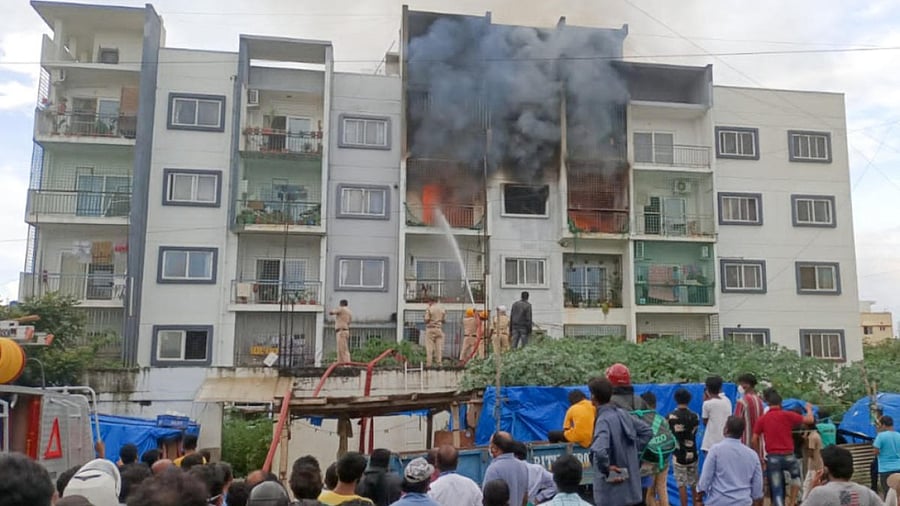
Crammed, congested and unplanned, Bengaluru could not have looked anywhere but vertical to contain the unrelenting pressure on living spaces. But in this decisive switch to high-rises, did the critical ‘fire safety’ get the attention it fully deserved? Not, if the recurring fire accidents are an indication.
Trapped inside a high-rise flat on fire, a 59-year-old woman and her elderly mother were charred to death in an apartment complex in the city’s Devarachikkanahalli. Trapped, because rescuers could not get through the sealed grille on the balcony.
But this September 24 incident exposes only one gap in a long list of fire safety requirements mandated both by law and experiences from the past: Lack of proper access for firefighting men and machines, absence of a culture of frequent mock drills, inadequate stock of fire safety equipment and few trained people who can actually use them.
Access issues
To address the access problem, the Bruhath Bengaluru Mahanagara Palike (BBMP) has directed all residential complexes not to install safety grilles in balconies. But one look at the thousands of high-rise apartments (buildings 15m tall and higher) that sees grilles as a defensive guard and a physical barrier, and you know grilled balconies are not going away in a hurry.
Also read: OPINION | Fire safety rules only on paper
Nor will fire safety be propelled to the top of everyone’s priority list. Campaigning for robust fire safety protocols ever since his son died in the horrific 2010 Carlton Towers accident, Uday Vijayan should know.
Through the collective, Beyond Carlton and its sustained activism, he did help fill a big gap in enforcement. Re-inspection of high-rises by the Karnataka State Fire and Emergency Services once every two years soon became a rule. Legal interventions ensured that the State Government made the necessary amendments to the fire safety laws, applicable to all high-rises across Karnataka.
Re-inspection of flats
Re-inspection is critical since violations crop up after the Occupancy Certificates (OCs) are issued, reminds Uday. “Before the 2011 government notification, BBMP would issue the OC only after the fire safety checks. But there was no way to check the violations after the approvals were given,” he recalls.
This was exactly the case with the Carlton Towers too. After nine people perished and 70 others were left injured in that accident, probe teams found that all the fire escape and access points were either covered or blocked.
Eleven years later, the State Fire and Emergency Services does have the power to re-inspect. Dedicated teams are now in place to inspect high-rises in Bengaluru, Mysuru, Mangaluru and Hubballi. However, the fast-paced vertical growth implies these teams are stretched far too thin. Staff shortage is a recurring problem.
Inspection costs
Steep inspection costs levied by the department is another issue. Notes Uday, “The fee ranges from Rs 2-3 lakh for an apartment. We have told the Fire Services that there should not be a fee beyond administration charges. High costs will be self-defeating, it will dissuade people from following fire safety guidelines.”
Robust preventive measures are key to fire safety. To ensure this in apartments, Beyond Carlton is now ready with a pilot to train residents in using extinguishers, responding quickly to fire breakouts, evacuation and more.
“We are looking at residents as fire wardens, people who are trained in the basics. We have set up a group of advisors to train them. The material will be whetted by experts.”
Containment, internally
The implication is clear: Before external help arrives, it is extremely important to try and contain a fire from within. Globally, cities with a high density of high-rises and super tall building blocks have perfected a system that mandates dedicated fully-filled overhead and internal water tanks, ready to pump water in case of emergencies. These pumps are required to be operational 24/7. Fire alarms and special valves that open up automatically are all part of this safety system.
Three years ago, in consultation with the Fire and Emergency Services and Janaagraha, Beyond Carlton had launched a five-year, city-specific blueprint for Bengaluru.
The objective was to make Bengaluru 100% fire safe in five years. With implementation challenges cropping up and the city’s vertical push accelerating, the target now looks ominous.